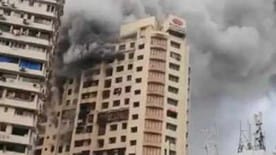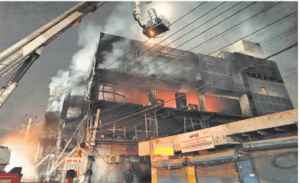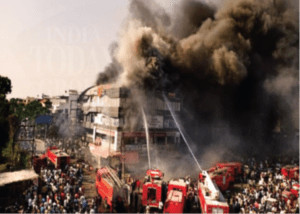31 Jan Fire Accidents in India – Need for Safety Measures
India’s high annual number of residential fires results in numerous deaths and property damage, posing a major threat to people’s lives and property.
Ensuring both the strict implementation of strong fire safety measures and the use of Flame Retardants (FRs), substances which play an essential role in preventing and slowing down ignition, represent thus crucial steps in tackling and solving the painful consequences of fire accidents within the country.
Accidental Fires – Places of Occurrence
India reported a total1 of 8,491 cases of fire accidents during 2021 which rendered 8,348 deaths and injuries to 485 persons. This averages to ~23 fire incidents and ~21 deaths due to fire accidents every day.
Residential buildings1 contributed to close to ~50% of total deaths from accidental fires. Most of these fire incidents are caused due to lack of Safety equipment and lack of knowledge about the solutions available to prevent fire hazards in homes. Both commercial and residential buildings, especially ones built without fire safety norms, are at the risk of having a fire incident without warning.

Graph 1: Loss of Lives in Accidental Fires, Nos., 2021
Major Causes for Fire Accidents
- Faulty Electrics: These are among the biggest cause of fires resulting due to lose wires, overloaded plugs, old equipment etc. The Chief Fire Officer of the Mumbai Fire Brigade, Hemant Parab, has highlighted that about 70 per cent of all fires that have broken out in Mumbai between 2019 and 2022 have electrical origins2.
- Non-adherence to National Building Code: The National Building Code (NBC), 2016 has set out elaborate guidelines including those for fire safety. However, there is very less compliance. Eg. NBC requires all buildings over 15 metres to carry out a fire safety audit once in two years by an independent entity which is not at all adhered to.
- Human Error: These include errors like storing flammable and combustible materials near ignition sources like in kitchen.
- Lack of Awareness among people: In many accidents, it has been observed that firefighting equipment had been installed, but the persons available there, were unaware on how to handle the equipment.
Recent Large Fires in India
Mumbai3 – Fire at Kamala building, Tardeo, 22nd Jan, 7:30 AM

Figure 1: Fire at Kamala Building, Mumbai
A massive fire broke out on the 19th floor of Sachinam Heights, locally called Kamala Building, which gutted one apartment on the 19th floor, the common corridor and the electric duct running along the length of the building. 6 people were killed while 23 were injured in the incident. The investigation report has not been able to conclude on the cause of the fire. However, is was observed that, the duct doors wherein TV and internet wires were connected, were left open on many floors of the 20-storey building which led to the quick spread of fire.
New Delhi4 – Fire at a commercial building, 13th May 2022

Figure 2: Fire at Mundka, New Delhi
The blaze engulfed a four-storied structure, housing the Cofe Impex Pvt Ltd unit which assembled electronic and surveillance equipment in the building. 27 persons were killed while 12 were injured in the incident. The building did not have a NOC (No Objection Certificate) from the fire department. It also violated the Factories Act, 1948 which requires the following to prevent outbreak of fire and its spread:
- Means of escape for all persons in the event of fire;
- Necessary equipment and facilities for extinguishing fire
Surat5 – Fire at Takshashila Arcade, 24th May 2019, 3:30 PM

Figure 3: Fire at Takshashila Arcade, Surat
A fire broke out in the ground floor of Takshashila Arcade located in the Sarthana area of the city. Students between the age of 15 and 19 were taking their coaching classes on the makeshift fourth floor. The alleged cause of the fire was reported to be an electrical short circuit in air-conditioner. The fire began at the ground floor, quickly engulfed the building including the staircases forcing the students to take shelter on the terrace. They eventually were trapped in the terrace. As the fire raged, as many as 22 died from the fire and the injuries they had sustained after jumping from the top floor as a means of saving themselves from the heat and fire.
Safety Measures to control Fire Accidents
- Following the National Building Code of India (NBC)6, 2016: The NBC is a comprehensive building code, published by the Bureau of India Standards. Part 4 of the NBC is titled ‘Fire and Life Safety’ and it provides guidelines for regulating the building construction activities across the country. States have been asked to incorporate it into their local building bylaws, making the recommendations a mandatory requirement. Part 8 of the NBC deals with “Building Services”. It is recommended that advice of a competent electrical engineer be sought at the initial stage itself with a view to providing an installation that will prove adequate for its intended purpose, be reliable, safe, and efficient. The code also mentions that it is desirable to use flame retardant cables and wires in electrical distribution systems.
- Following the Model Building Bye Laws7, 2019: These Bye Laws have been devised by the Ministry of Urban Development which states the regulatory mechanism and engineering parameters to keep in mind before starting any construction project in India. These laws also recommend that all wires and other accessories used in Staircase and Corridor Emergency lighting should have fire retardant property. Sub-station buildings should also use fire retardant cables to avoid chances of spread of fire.
- Regular Audits: There should be time-bound fire and electric audits of all high-rise buildings, hospitals, schools and commercial places.
- Mock Drills: The fire services should conduct regular fire safety drills so that people are aware of what to do in the event of a fire incident
- Revamp of Fire Safety Department:Fire safety operations in urban India fall under municipalities, a tier of governance that is particularly weak. A consequence of it is that firefighting operations are starved of resources. As of Dec’18, India had only 3,377 fire stations7 which is ~39% of the total requirement of 8,559. The government should provide financial support and assistance in augmenting and modernising the fire departments.
Sources:
- Accidental Deaths & Suicides in India 2021, National Crime Records Bureau Ministry of Home Affairs
- https://indianexpress.com/article/cities/mumbai/mumbai-70-of-fires-in-city-due-to-electrical-issues-says-official-8203316/
- https://timesofindia.indiatimes.com/city/mumbai/mumbai-fire-breaks-out-in-20-storey-kamala-building-in-tardeo/articleshow/89051980.cms
- https://vajiramandravi.s3.us-east-1.amazonaws.com/media/2022/5/14/13/9/20/Fire_Safety.pdf
- https://nidm.gov.in/PDF/pubs/Fires_in_India_2020.pdf
- National Building Code, 2016
- The Model Building Bye Laws, 2016
- https://www.mha.gov.in/MHA1/Par2017/pdfs/par2019-pdfs/rs-26062019/516.pdf




No Comments